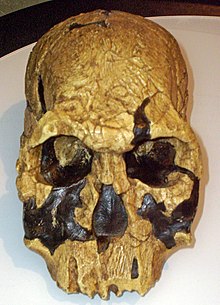Homo rudolfensis
| Homo rudolfensis Temporal range: Pliocene
| |
|---|---|

| |
| The KNM ER 1470 skull. | |
| Scientific classification | |
| Kingdom: | |
| Phylum: | |
| Class: | |
| Order: | |
| Family: | |
| Genus: | |
| Species: | H. rudolfensis
|
| Binomial name | |
| †Homo rudolfensis Alekseyev, 1986
| |

Homo rudolfensis is a fossil human species discovered by Bernard Ngeneo, a member of a team led by anthropologist Richard Leakey and zoologist Meave Leakey in 1972, at Koobi Fora on the east side of Lake Rudolf (now Lake Turkana) in Kenya. The scientific name Homo rudolfensis was proposed in 1986 by V. P. Alekseyev for the specimen Skull 1470 (KNM ER 1470). Skull 1470 has an estimated age of 1.9 million years.
Originally thought to be a member of the species Homo habilis, the fossil was the center of much debate concerning its species. Assigned initially to Homo habilis, the skull was at first incorrectly dated at nearly three million years old. The differences in this skull, when compared to others of the Homo habilis species, are too pronounced, leading to the presumption of a Homo rudolfensis species, contemporary with Homo habilis. It is not certain if H. rudolfensis was ancestral to the later species in Homo, or if H. habilis was, or if some third species yet to be discovered was.
In March 2007, a team led by Timothy Bromage, an anthropologist at New York University, reconstructed the skull of KNM-ER 1470. The new construction looked very ape-like (possibly due to an exaggerated rotation of the skull[1]) and the cranial capacity based on the new construction was reported to be downsized from 752 cm³ to about 526 cm³, although this seemed to be a matter of some controversy.[2] Bromage published his results in 2008 where the cranial capacity was now estimated at 700 cm³.[3] Bromage said his team’s reconstruction included biological principles not known at the time of the skull’s discovery, which state that a mammal’s eyes, ears and mouth must be in precise relationships relative to one another.[2]
See also
- Cranial capacity
- List of fossil sites (with link directory)
- List of hominina (hominid) fossils (with images)
References
- ^ John Hawks (31 March 2007). "KNM-ER 1470 is not a microcephalic".
- ^ a b Than, Ker (29 March 2007). "Controversial Human Ancestor Gets Major Facelift". LiveScience. Retrieved 2007-04-28.
- ^ Bromage TG, McMahon JM, Thackeray JF; et al. (2008). "Craniofacial architectural constraints and their importance for reconstructing the early Homo skull KNM-ER 1470". The Journal of Clinical Pediatric Dentistry. 33 (1): 43–54. PMID 19093651.
{{cite journal}}: Explicit use of et al. in:|author=(help)CS1 maint: multiple names: authors list (link)
External links
- Archaeology Info
- Science Daily article
- Talk Origins - Skull KNM-ER 1470
- Homo rudolfensis - The Smithsonian Institution's Human Origins Program
